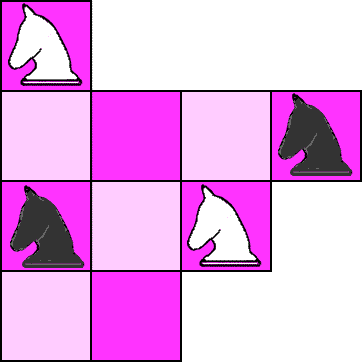Skip over navigation

Two white and two black knights are positioned on part of a chess board as shown.
A knight can only move in the usual way * and can only land on an empty square.
Swap the positions of the white and black knights.
Can you prove you have succeeded in the minimum number of moves?
* A knight can move two squares horizontally and one square vertically, or two squares vertically and one square horizontally. The complete move therefore looks like the letter 'L'.
Unlike all other standard chess pieces, the knight can 'jump over' all other pieces on route to its destination square.

Or search by topic
Number and algebra
Geometry and measure
Probability and statistics
Working mathematically
Advanced mathematics
For younger learners
Knights Moving
Age 16 to 18
Challenge Level 






Two white and two black knights are positioned on part of a chess board as shown.
A knight can only move in the usual way * and can only land on an empty square.
Swap the positions of the white and black knights.
Can you prove you have succeeded in the minimum number of moves?
* A knight can move two squares horizontally and one square vertically, or two squares vertically and one square horizontally. The complete move therefore looks like the letter 'L'.
Unlike all other standard chess pieces, the knight can 'jump over' all other pieces on route to its destination square.
You may also like
A Knight's Journey
This article looks at knight's moves on a chess board and introduces you to the idea of vectors and vector addition.

